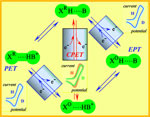Publication
664
Acc. Chem. Res.,
43, 1019 -1029, 2010.
DOI: 10.1021/ar9002812
|
|
|
|
|
 |
Concerted Proton-Electron Transfers: Electrochemical and Related Approaches |
|
|
|
|
|
Cyrille Costentin, Marc Robert, and Jean-Michel Savéant
Laboratoire d'Electrochimie Moléculaire, Université Paris Diderot, UMR CNRS 7591, 15, rue Jean-Antoine de Baïf, 75205 Paris Cedex 13, France
Proton-coupled electron transfers (PCETs) are omnipresent in natural and artificial chemical processes. Given the contemporary challenges associated with energy conversion, pollution abatement, and the development of high-performance sensors, a greater understanding of the mechanisms that underlie the practical efficiency of PCETs is a timely research topic.
In contrast to hydrogen-atom transfers, proton and electron transfers involve different centers in PCET reactions. The reaction may go through an electron- or proton-transfer intermediate, giving rise to the electron−proton transfer (EPT) and the proton−electron transfer (PET) pathways. When the proton and electron transfers are concerted (the CPET pathway), the high-energy intermediates of the stepwise pathways are bypassed, although this thermodynamic benefit may have a kinetic cost. The primary task of kinetics-based mechanism analysis is therefore to distinguish the three pathways, quantifying the factors that govern the competition between them, which requires modeling of CPET reactivity. CPET models of varying sophistication have appeared, but the large number of parameters involved and the uncertainty of the quantum chemical calculations they may have to resort to make experimental confrontation and inspiration a necessary component of model testing and refinement.
Electrochemical PCETs are worthy of particular attention, if only because most applications in which PCET mechanisms are operative involve collection or injection of electricity through electrodes. More fundamentally, changing the electrode potential is an easy and continuous means of varying the driving force of the reaction, whereas the current flowing through the electrode is a straightforward measure of its rate. Consequently, the current−potential response in nondestructive techniques (such as cyclic voltammetry) can be read as an activation−driving force relationship, provided the contribution of diffusion has been taken into account. Intrinsic properties (properties at zero driving force) are consequently a natural outcome of the electrochemical approach.
In this Account, we begin by examining the modeling of CPET reactions and then describe illustrating experimental examples inspired by two biological systems, photosystem II and superoxide dismutase. One series of studies examined the oxidation of phenols with, as proton acceptor, either an attached nitrogen base or water (in water as solvent). Another addressed interconversion of aquo-hydroxo-oxo couples of transition metal complexes, using osmium complexes as prototypes. Finally, the reduction of superoxide ion, which is closely related to its dismutation, allowed the observation and rationalization of the remarkable properties of water as a proton donor. Water is also an exceptional proton acceptor in the oxidation of phenols, requiring very small reorganization energies, both in the electrochemical and homogeneous cases. These varied examples reveal general features of PCET reactions that may serve as guidelines for future studies, suggesting that research emphasis might be profitably directed toward new biological systems on the one hand and on the role of hydrogen bonding and hydrogen-bonded environments (such as water or proteins) on the other. |

